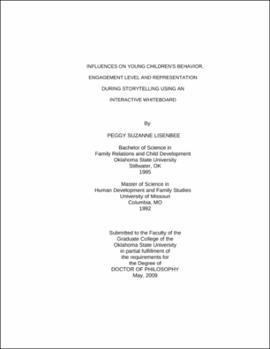| dc.contributor.advisor | Castle, Kathryn | |
| dc.contributor.author | Lisenbee, Peggy Suzanne | |
| dc.date.accessioned | 2013-11-26T08:34:41Z | |
| dc.date.available | 2013-11-26T08:34:41Z | |
| dc.date.issued | 2009-05 | |
| dc.identifier.uri | https://hdl.handle.net/11244/7486 | |
| dc.description.abstract | Scope and Method of Study: The purpose of this study was to examine the influences on young children's behavior, engagement level and representation during storytelling using an interactive whiteboard. The study consisted of observations and interviews of four pairs of students as they were re-telling the story of Goldilocks and the Three Bears on an interactive whiteboard. A first grade classroom was identified by a teacher responding to an email. The sole criterion that I gave the teacher was for her to select eight participants that have the ability to complete a storytelling activity independently while using an interactive whiteboard. Each participant was observed as they completed the storytelling and then immediately interviewed about their experience using an interactive whiteboard. The methodological framework was a qualitative, descriptive naturalistic study analyzed through the lens of the Interpretivist and Deconstructionist paradigms. Specifically, I used the Constructivist Theory and Poststructural perspective, Third Space, to explain the data from this study. | |
| dc.description.abstract | Findings and Conclusions: The observations and interviews were transcribed and then coded in order to identify themes. Five themes emerged from the data analysis. The themes were Use of Technology, Representations, Peer Cooperation, Enjoyment, and Dissonance. The validity of the data was analyzed using rich, thick descriptions, peer debriefing, reflexivity, and methodological and theoretical triangulation of data. Interpretations from the data provided support for using interactive whiteboards in classrooms. Students used reasoning to choose images, determine placement of images and dimensions of images during their storytelling experiences. However, students did not make transformative representations. Students cooperated during storytelling, laughed, sang, provided instructional communication, responded with positive affirmations, and exclamations of amazement. Yet, students also engaged in power struggles, negative comments, statements of "no", physically acted against each other, and had issues with technology. The most substantial theme was Dissonance. Since students were in a state of dissonance due to their inability to independently use an interactive whiteboard, the Lisenbee EMSCI Model was created for teachers to use so they could teach students to independently use technological tools. | |
| dc.format | application/pdf | |
| dc.language | en_US | |
| dc.rights | Copyright is held by the author who has granted the Oklahoma State University Library the non-exclusive right to share this material in its institutional repository. Contact Digital Library Services at lib-dls@okstate.edu or 405-744-9161 for the permission policy on the use, reproduction or distribution of this material. | |
| dc.title | Influences on young children's behavior, engagement level and representation during storytelling using an interactive whiteboard | |
| dc.contributor.committeeMember | Brown, Pamela | |
| dc.contributor.committeeMember | Wang, Hongyu | |
| dc.contributor.committeeMember | Lane, Mona | |
| osu.filename | Lisenbee_okstate_0664D_10241.pdf | |
| osu.accesstype | Open Access | |
| dc.type.genre | Dissertation | |
| dc.type.material | Text | |
| dc.subject.keywords | behaviors | |
| dc.subject.keywords | constructivist | |
| dc.subject.keywords | interactive whiteboard | |
| dc.subject.keywords | teaching | |
| dc.subject.keywords | technology | |
| dc.subject.keywords | third space | |
| thesis.degree.discipline | Curriculum Studies | |
| thesis.degree.grantor | Oklahoma State University | |
